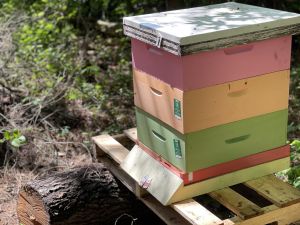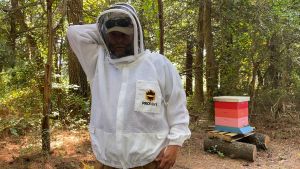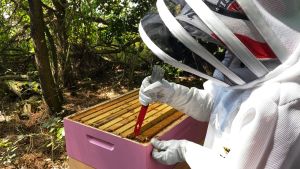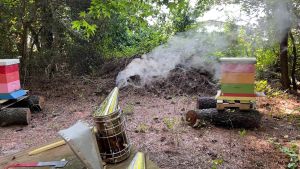
Honey Bees
Honey bees are the workhorse behind pollination. For being so small their role in a healthy ecosystem is amazingly large. Without these essential bees the consequences to our food system would be devastating.
What Honey Bees Do
Pollination: Basically honey bees are responsible for keeping the entire world’s plant species alive and reproducing. They are responsible for pollinating an extremely wide variety of plants. This nearly never ending work is what allows for biodiversity, which is what we are striving for on our farms and homesteads.
Honey production: Through the tireless efforts of Mr Buzz Buzz and his team of worker bees the bee hive is (hopefully) full of honey. Honey production starts with the honey bees collecting nectar from flowers. Through a process of enzymatic reactions, yes big words, bees convert nectar into honey. This honey is then stored in honeycomb cells in the hive. The bees go through this process to store honey for the colder winter months.
Honey Bees and the Ecosystem
Impact on Food Production: As mentioned above, honey bees keep the world fresh, green and full of flowers. However, they are absolutely critical to our food supply by pollinating crops. If it were not for honey bees we would not have a significant portion of the fruits and vegetables we eat everyday. OMG a world without apples or watermelon, no thank you.
Effects on Wildlife: These super pollinators are responsible for keeping balance in ecosystems, kind of like Jedi’s bringing balance to the force, lol. Without these bees many of the critters that rely on fruits, vegetables, flowers or other plants to eat would not survive. This would obviously have a spider web of consequences. Once the prey and predator equation gets shifted, an out of balance ecosystem will change dramatically. Not to mention the impact on the four legged protein sources we consume.
Threats: Some of the threats to bees we can help control while others are mother nature. Pesticides and habitat loss are two of the main threats to honey bees that we can help control. Mother nature takes a toll on bees with disease and parasites. How can we help the honey bee population? We can provide a daily buffet of nectar by planting fruit trees, vegetable and flower gardens. You can start your own bee hives and help increase the population. But the biggest way is to stop using synthetic pesticides, herbicides and fertilizers.
Honey Production Process
Foraging Behavior: Well the bees obviously gotta Jump, Jive An’ Wail. Ok, I know it’s a stretch. But bees do communicate with dances and scents. The “Waggle Dance” is used to communicate where to find the location of nectar-rich flowers. They use the dance and the accumulated pollen smell to share with their pollinating team members the flower patch is.
Honey Making Inside the Hive: Who knew bees were Master Chemists? Once back in the hive these tireless worker bees evaporate water from the nectar then we are back to the enzymatic process. Here bees add enzymes into the nectar to start the conversion to honey. Once the honey is made it is stored in the honeycomb cells and is sealed with wax for preservation.
Honey Bees and Beekeeping
Beekeeping equipment: The starter kit includes a beehive (yes, earth shattering revelation), bee suit, gloves and veil. Then we get into a smoker, bee hive tools and in order to reap the benefits of the bees’ hard work, we need a honey extractor. Here is a little more detailed list.
Honey Bee Hive – Lots of options here, but probably the best for beginners is to just buy a starter kit. A really great option is to check with your local Ag Extension office to see if they have any resources available. Definitely will want a stand to keep the hive(s) off the ground.
Bee Suit – You can use a full suit or a jacket. This will include a veil and gloves. Humble Bee makes a great suit and has tons of sizes to choose from.
Hive Tool – Basically the Wonder Bar of beekeeping. Used to pry your hive open.
Smoker – Used to calm your bees down.
Bee Brush – To brush bees off the frames.
Honey Extractor – Almost like a hand crank clothes washer. It is used to spin the honey out of the frames.
Honey Harvesting Process: When is honey ready to harvest? Beekeepers review the amount of capped honeycomb cells and when they are full it is time to harvest. Using the smoker to calm the bees we remove the frames and take them to the extractor.
Believe it or not, honey bees are one of the most critical components of a healthy ecosystem. These little critters grin out tons of work while tending to our food supply in the way of pollination. It is absolutely essential that these honey bees are taken care of and the populations remain high. Next time one of these guys is trying to join your picnic, remember all the good they do.





